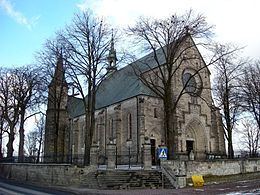Gmina Żarnów Local time Monday 2:01 AM | Population 870 | |
 | ||
Weather 10°C, Wind NW at 10 km/h, 83% Humidity | ||
Żarnów [ˈʐarnuf] is a village (a town in 1415–1876) in Opoczno County, Łódź Voivodeship, in central Poland. It is the seat of the gmina (administrative district) called Gmina Żarnów. It lies approximately 18 kilometres (11 mi) south-west of Opoczno and 77 km (48 mi) south-east of the regional capital Łódź. The village has a population of 870 and belongs to historic province of Lesser Poland. Its name most probably comes from the phrase miejsce żarne - burned-out area, and refers to burning of forests in Slavic times, to make fields. Żarnów has a long history, in the early years of Polish state it was a major urban center of the country. The first written mention of the village dates from 1065. It was the site of a major battle (the Battle of Żarnów) during the Swedish invasion of Poland (The Deluge), in 1655.
Contents
Map of %C5%BBarn%C3%B3w, Poland
History
Żarnów was founded before 1065, as the first written mention of the village comes from that year, and it had already existed. It was home to one of the oldest Polish castellanies, with a church founded in 1111 by prince Bolesław Krzywousty as a votum for his victories in a war with Pomeranian tribes. In 1136, a papal bull of Innocent II mentioned Sarnov as one of major grods of Central Poland, together with other administrative centers of the area - Skrzynno and Małogoszcz (the three towns made the so-called Pilica castellanies). In 1191 Żarnów's parish church (most likely founded by Prince Casimir II the Just) was mentioned among seven major churches of the Sandomierz collegiate church. In the 12th century Żarnów was an important urban center of northern Lesser Poland, with its own gord and church. In 1415 Żarnów received a town charter, and despite losing its importance to the nearby town of Opoczno, the title of Castellan of Żarnów remained in use until the Partitions of Poland.
In 1795 Żarnów was annexed by the Austrian Empire. In 1815, it became part of Russian-controlled Congress Poland. Like many other towns of northern Lesser Poland, Żarnów lost its town privileges in 1876. The Russians reduced it to the status of a village for residents’ participation in the January Uprising.
